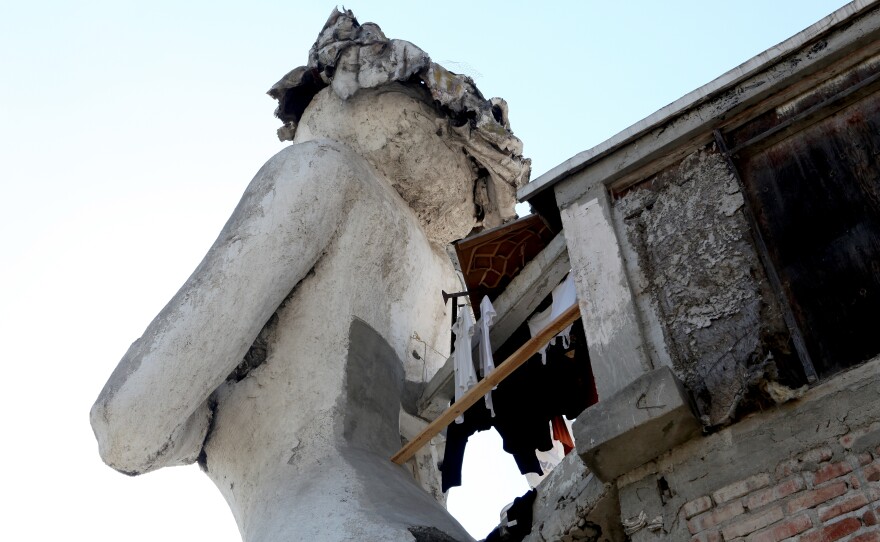We're lost in Mexico.
You'd think a five-story house in the shape of a naked woman would be easy to find.
KPBS videographer Katie Euphrat and I are following directions that don't include street names. We've been instructed to take a left at an OXXO convenience store (Mexico's 7-Eleven) and a right at an electricity station.
I see her white concrete face first - above the rooftops, looking towards the ocean. I visited the house before, back in 2010. I immediately start laughing because I know what's to come and because the whole thing is absurd, in the best way. Soon Katie spots her as well, and we make our way towards the visage. Once on the right dirt road, we get our first full frontal view. Katie's face upon seeing the house is priceless.
How could it not be? After all, this house has very large breasts.
"It’s kind of not a regular kind of house is it?" laughs Armando Muñoz García, charmingly stating the obvious. He greets us at the door.
Clean-cut and chivalrous, Muñoz has spent 18 years building the house which is in the shape of woman from the waist up. He says it’s 90 percent finished. Though it’s a mermaid, she has no tail and the focus is clearly on her bare torso and its assets.
Locals call the house "La Sirena," or "the mermaid."

"Everyone knows where is La Sirena now. And people call me "sireno," which is the mermaid male," Muñoz explains.
At the base of the statue is a pool, painted purple and empty the day we were there. The mermaid’s body is white. She’s surrounded by large swirls of concrete seaweed painted a bright red. Her head and hair aren’t finished, so strands of rebar stick up out of the concrete.
Muñoz converted the house into a restaurant last year. What used to be Muñoz's living room, behind the woman's belly, is now a restaurant that seats 35. Muñoz does most of the cooking and only takes reservations. He describes the menu as French and Mexican gourmet. This is how he makes a living now, along with selling keepsakes of the house.
The third floor (behind the chest) is a gallery, the fourth an open-air bedroom, and the fifth a rooftop studio. These aren't carefully curated spaces, with the perfect sofa, well-placed plant, or pillowed bed. Each floor has the feel of an artist's studio as it might look in the middle of a project: buckets are in corners, plastic covers and tools are scattered. Muñoz hopes to complete the mermaid in a few months.
He has many neighbors. Muñoz insists they’ve been supportive of his creation. "I didn’t find any reaction or pressure to stop this building. In fact, it was the opposite." This should be startling to any U.S. citizen, where suburban noses turn skyward at a poorly maintained lawn or a couch on the front porch; Heads would explode if the house next door got a boob job like this.
Muñoz is not an architect or a trained sculptor. He left school when he was young and began painting at 14. He’s spent his life building statues he can live in.

Muñoz takes us into Tijuana to see the statue for which he's most famous. It’s a 55-foot tall female nude (similar measurements to the mermaid) that he built in the 1980s.
She's called "La Mona," or "the doll." She’s become an icon - sometimes referred to as Tijuana's Statue of Liberty. Muñoz, who was born in Tijuana, created La Mona as a tribute to his home town's centennial. It was the first statue he ever built and he decided to go 55 feet and naked. Muñoz dreams and builds big.

We climb down stairs made of tires into a trash-strewn valley. Along the hillside is a squatter’s neighborhood called Colonia Aeropuerto, where resourceful residents use whatever materials they can find to build makeshift homes. La Mona rises out of the hillside glorious, but in need of repair. She seems as much a protector of this neighborhood as the many dogs who snarl and bark at us.
La Mona's arm is raised and her pinky finger extends to the sky. "That small finger to the sky signifies Tijuana on the Mexican map," explains Muñoz.
Urban legends and myths have cropped up around La Mona. Muñoz clears one up: La Mona is not based on an ex-girlfriend.
Muñoz heard another legend while sharing a cab. The taxi driver – who didn’t realize the statue’s creator was in his cab - told him and his fellow passengers that La Mona was built by a dwarf who went insane after falling in love with a very tall white woman. "It was amazing," remembers Muñoz. "He never doubted the story once. I’m very sure he's told this same story a thousand times."
Muñoz never revealed whom he was. At that point, he didn't think the cab driver would believe him.
La Mona is no shrinking violet. Her legs are muscled and her body full-figured. Muñoz says he's very particular about choosing robust body type for his statues. He doesn't want them to have "weak, fragile legs or chest."
At this point you might be wondering why Muñoz keeps building large statues of naked women. For him, working with the female anatomy is a way to celebrate Mexican women. "Women in Mexico are so strong, so powerful," says Muñoz. "In Mexico, the one who rules the house, the one who rules everything, is wife."

Even though tourism has dropped in recent years, Muñoz hopes people will visit the mermaid, which is located just south of touristy Rosarito. As soon as she’s complete, he has another even larger statue in mind, though he won’t share details.
When I ask if it will be in his beloved Tijuana, Muñoz responds: "Of course, where else?"






